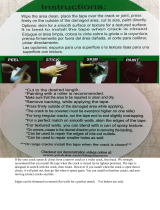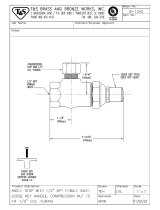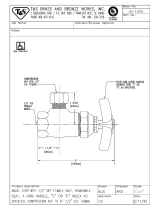
INSTALLATION INSTRUCTIONS
483
HAM-LET ADVANCED CONTROL TECHNOLOGY
H-500 SERIES
3-PIECE BALL VALVES
1. Use:
1.1 For maximum valve life, use the valve only within
the stated pressure and temperature range, and
in accordance with the corrosion resistance of the
material. Give particular attention to the compatibility
of the O-ring material.
2. Manual Operation
2.1 To open or close the valve, turn the handle 1/4
of a turn (90 degrees).
A. When the valve is in the Open Position, the handle
is parallel (in-line) with the valve or pipeline.
B. When the the valve is in the Closed Position, the
handle is perpendicular (crossed) to the valve or
pipeline.
3. Automated Operation
3.1 Check any valve with an actuator for valve-stem
alignment. Angular or linear misalignment will result in
high operational torque and unnecessary wear on the
stem seal.
4. Disassembling & Cleaning of the Valve:
A ball valve can trap uids in the ball cavity when it is in the
closed position. If the valve has been used in a hazardous
medium, decontaminate it before disassembly.
A. Relieve the line pressure.
B. Place the valve in the half-open position and ush
the line to remove any hazardous material from the valve.
C. All persons involved in the removal and disassembly
of the valve should wear proper protective clothing, such
as face shields, gloves, aprons, etc.
5. Replacing Seats, Joint Gaskets, Stem
Seal and Stem Packing
Model H-500 is designed with Belleville washers for
automatic seal wear compensation. If there is any sign
of leakage from the stem, replace the stem packing and
the stem seal. If there is any sign of internal leakage,
replace the ball seats.
5.1 When replacing the seats and joint gaskets, refer
to the assembly diagram.
A. Follow the above Disassembling & Cleaning
Instructions (number 4, above). Make sure the
pipeline is de-pressurized.
B.
With the valve in the open position (lever parallel
to the axis of the pipe), loosen all the nuts on the
body bolting. Remove all the bolts except one. Swing
the body outside the pipe.
C.
Turn the handle to the half-open position to assist in
the removal of the seats.
D.
Replace with a new set of seats and joint gaskets.
E.
Swing the body back into position. Replace the
removed bolt, and tighten the bolts according to the
Bolt
Tight
ening Specication Table on the next page.
5.2
When replacing the stem seal and stem packing, refer to
the assembly diagram.
A.
Follow the direction for replacing the seats and joint
gaskets from 5.1.A to 5.1.C.
B.
To assist in loosening the stem nut, place a rod of
a diameter smaller than the ball orice into the ball orice.
Loosen and remove the top stem nut with a wrench.
Remove the stem washer, handle and lock saddle.
Place all removed parts in a clean and secure place.
C.
Loosen and remove the second stem nut with a
wrench.
Remove the set of Belleville washers. Place all removed
parts in a clean and secure place.
D. Remove the rod. Turn the valve to the closed position
(handle perpendicular to the pipeline). Remove the seats
and gaskets. The ball should slide out with a gentle push.
Place all removed parts in a clean and secure place.
E.
Push the stem downward. It should come out through
the center body. Remove the stem, then remove the
stem seal.
Thoroughly clean the stem. Replace it with a new stem
seal.
F.
Remove the stem packing from the center body cavity.
Thoroughly clean the center body. Insert a new stem
packing.
G.
Replace the stem, the Belleville washers and the gland.
Replace the rst stem nut. To tighten the nut, hold the
stem in place and tighten the nut with a wrench. When
tightening the stem nuts, make sure they are snug and
the Belleville washer is compressed to the maximum
extent.
Replace the lock saddle, the stem handle, the stem
washer and the top stem nut.
Tighten the top stem nut with a wrench.
H. Turn the valve to the closed position (handle
perpendicular to the pipeline). Replace the ball. Turn the
valve to the open position (handle parallel to the pipeline).
Replace the seats and joint gaskets.
I. Swing the center body back into position. Replace
the removed bolts and nuts. Tighten the nuts according
to the Bolt Tightening Specication Table.



























